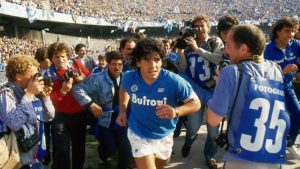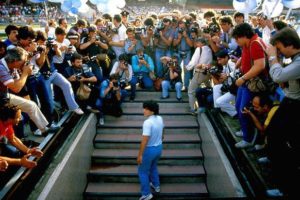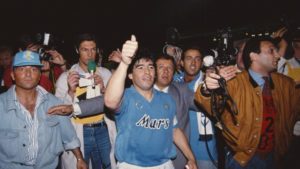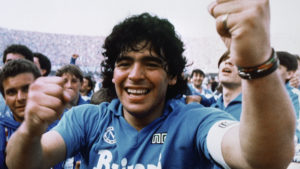Movie Review: Diego Maradona

Following his award-winning documentaries on Ayrton Senna and Amy Winehouse, British filmmaker Asif Kapadia declared that his new film regarding Argentine football legend Diego Maradona completes the third part of his trilogy about child geniuses and fame. The term more appropriate here is troubled genius perhaps because, in Maradona, Kapadia explores the duality of the private individual and the public persona and how these were often in constant conflict with one another. One does not have to be an aficionado of soccer to know how the central narrative thread of one of the game’s greatest talents goes. Raised in the underprivileged Villa Fiorito outskirts of Buenos Aires, Maradona reached the very pinnacle of his career in the 1980s playing for his country and clubs Barcelona and Napoli. He captained Argentina as they won the World Cup in Mexico in 1986, a tournament many credit him for having won single-handedly. His subsequent decline as a player and the controversies which raged around his substance abuse problem were also matters in the full glare of the public eye. At several points during this two-hour-plus documentary, Kapadia emphasies the dichotomy which existed between Diego the man and Maradona the icon. The subject matter himself acknowledges as much in a telling voiceover as he contemplates how the game offered an escape from poverty initially and – later on – personal demons. Constructed from over 500 hours of archival footage (much of it never seen before), the film offers up an incredibly intimate portrait of the man and the extraordinary adulation which surrounded him. As with 2010’s Senna, Kapadia has succeeded in uncovering several more aspects to the character than many of us would have appreciated heretofore.

The central spine of the story begins on the heady day of July 5th 1984. Bought for a then world record fee of €6.9 million, Maradona is presented at the Stadio San Paolo to his new club Napoli and some 80,000 fans. The atmosphere is electric and shot through with more than a modicum of hope and expectation. The club has never won the coveted Scudetto (Serie A title) to that point in time with teams from the North, such as Juventus and A.C. Milan, tending to dominate. The twenty-three year-old Diego can hardly comprehend the political and economic divide between North and South Italy which was especially prominent during this particular era. Also, when asked about his knowledge of the Camorra crime syndicate in Naples, the young footballer’s puzzled expression tells us something about his general naivety. This, of course, would change over the course of time and Kapadia signals the difficult days which would follow as he picks out some pictures of the star footballer posing with members of Campania’s mafia organisation. The years 1984 to 1992 are essayed by Kapadia as Maradona’s influence and immense skills on the football pitch transformed Napoli from a relegation-threatened club to the champions of Italy (the 1986-1987 season and, again, in the 1989-1990 season). During this time period, the great one also won the World Cup with his beloved Argentina (Mexico 1986). The infamous quarter-final against England is, unsurprisingly, of considerable interest here as Maradona scores both the Hand of God goal and the goal of the century. The Falklands War of four years before is alluded to and the resulting triumph and celebrations back home confirm the player’s unofficial status as a modern-day saviour. But Kapdia’s film is chiefly concerned with events which unfolded in Naples in subsequent years and it is to there that we return.

Napoli finally captured their first national title in 1987 and the city partied like never before in the weeks which followed. The expression football crazy finds new superlatives here. Details of Maradona’s messianic-like standing are imparted over images of congested streets and sounds of blaring horns. His image sits aloft with that of Christ in many Neapolitan homes. A vial of his blood finds its way to a church as the seemingly devout followers become near-acolytes. But in the midst of such triumph and jubilation, some words of nascent disquiet are offered by the film and the former player himself. The all-consuming atmosphere of reverance quickly became suffocating. It ground down Diego the man and Maradona the icon became more elevated. Noteworthy features of subsequent seasons were the drinking and partying which occurred until the midweek, followed by the intense training and purging which took place before the Serie A fixture every Sunday. Diego’s cocaine addiction took hold during the latter years of the 1980s, but the protection he enjoyed from factions such as the Camorra ensured that his drug habit remained Naples’s worst kept secret. This situation changed quite dramatically after the World Cup of 1990.

The semi-final between Argentina and Italy which took place in the Stadio San Paolo in Naples becomes a seismic moment in Kapadia’s film and Maradona’s story. On more than one occasion, the decision to stage the game at Maradona’s club stadium is referred to as a mistake of some significance. Of greater import – and detriment – was the player’s own articulated assumption that the ordinary Neapolitans might support his country against their own. In a moment of some naivety once again, Maradona refers to the North-South divide as his reasoning for this. Big mistake of course. No Italian took kindly to the home nation’s elimination on penalties on that fateful night in the Campania capital. In popular parlance, the match was a game-changer and Maradona himself only seems to realise this as the Argentinian national anthem is booed prior to the start of the World Cup Final against West Germany at the Stadio Olimpico in Rome. The player’s subsequent decline and brushes with the law are painstakingly traced by Kapdia after this. The saddest sight of all perhaps is that of a fallen Maradona departing Naples Airport in 1992 following a lengthy ban for cocaine use. In an emotional voiceover, the former star remarks on how thousands greeted him upon his arrival there in 1984 in stark contrast to his departure some eight years later. A tearful 2004 interview on Argentinian television further illustrates the theme of celebrity coming at far-too-high a price. But the man, thankfully, is still with us and a meeting with the son whom he had denied for years in 2016 posits the hope of his having reached a somewhat peaceful place. Kapadia’s documentary is one of the highest order and the headline here is that you do not need to be a fan of football to appreciate its craft and design in the same way that you did not have to be remotely interested in Formula 1 to cherish the director’s Senna. Rebel. Hero. Hustler. God. To many Maradona was many of these things. Happily, through the medium of Kapadia’s film, Diego the man also emerges here and becomes the true hero of the piece.
Rating: A